Jia Zhu
Automatic Failure Attribution and Critical Step Prediction Method for Multi-Agent Systems Based on Causal Inference
Sep 10, 2025Abstract:Multi-agent systems (MAS) are critical for automating complex tasks, yet their practical deployment is severely hampered by the challenge of failure attribution. Current diagnostic tools, which rely on statistical correlations, are fundamentally inadequate; on challenging benchmarks like Who\&When, state-of-the-art methods achieve less than 15\% accuracy in locating the root-cause step of a failure. To address this critical gap, we introduce the first failure attribution framework for MAS grounded in multi-granularity causal inference. Our approach makes two key technical contributions: (1) a performance causal inversion principle, which correctly models performance dependencies by reversing the data flow in execution logs, combined with Shapley values to accurately assign agent-level blame; (2) a novel causal discovery algorithm, CDC-MAS, that robustly identifies critical failure steps by tackling the non-stationary nature of MAS interaction data. The framework's attribution results directly fuel an automated optimization loop, generating targeted suggestions whose efficacy is validated via counterfactual simulations. Evaluations on the Who\&When and TRAIL benchmarks demonstrate a significant leap in performance. Our method achieves up to 36.2\% step-level accuracy. Crucially, the generated optimizations boost overall task success rates by an average of 22.4\%. This work provides a principled and effective solution for debugging complex agent interactions, paving the way for more reliable and interpretable multi-agent systems.
E3-Rewrite: Learning to Rewrite SQL for Executability, Equivalence,and Efficiency
Aug 12, 2025Abstract:SQL query rewriting aims to reformulate a query into a more efficient form while preserving equivalence. Most existing methods rely on predefined rewrite rules. However, such rule-based approaches face fundamental limitations: (1) fixed rule sets generalize poorly to novel query patterns and struggle with complex queries; (2) a wide range of effective rewriting strategies cannot be fully captured by declarative rules. To overcome these issues, we propose using large language models (LLMs) to generate rewrites. LLMs can capture complex strategies, such as evaluation reordering and CTE rewriting. Despite this potential, directly applying LLMs often results in suboptimal or non-equivalent rewrites due to a lack of execution awareness and semantic grounding. To address these challenges, We present E3-Rewrite, an LLM-based SQL rewriting framework that produces executable, equivalent, and efficient queries. It integrates two core components: a context construction module and a reinforcement learning framework. First, the context module leverages execution plans and retrieved demonstrations to build bottleneck-aware prompts that guide inference-time rewriting. Second, we design a reward function targeting executability, equivalence, and efficiency, evaluated via syntax checks, equivalence verification, and cost estimation. Third, to ensure stable multi-objective learning, we adopt a staged curriculum that first emphasizes executability and equivalence, then gradually incorporates efficiency. Extensive experiments show that E3-Rewrite achieves up to a 25.6\% reduction in query execution time compared to state-of-the-art methods across multiple SQL benchmarks. Moreover, it delivers up to 24.4\% more successful rewrites, expanding coverage to complex queries that previous systems failed to handle.
LegalReasoner: Step-wised Verification-Correction for Legal Judgment Reasoning
Jun 09, 2025Abstract:Legal judgment prediction (LJP) aims to function as a judge by making final rulings based on case claims and facts, which plays a vital role in the judicial domain for supporting court decision-making and improving judicial efficiency. However, existing methods often struggle with logical errors when conducting complex legal reasoning. We propose LegalReasoner, which enhances LJP reliability through step-wise verification and correction of the reasoning process. Specifically, it first identifies dispute points to decompose complex cases, and then conducts step-wise reasoning while employing a process verifier to validate each step's logic from correctness, progressiveness, and potential perspectives. When errors are detected, expert-designed attribution and resolution strategies are applied for correction. To fine-tune LegalReasoner, we release the LegalHK dataset, containing 58,130 Hong Kong court cases with detailed annotations of dispute points, step-by-step reasoning chains, and process verification labels. Experiments demonstrate that LegalReasoner significantly improves concordance with court decisions from 72.37 to 80.27 on LLAMA-3.1-70B. The data is available at https://huggingface.co/datasets/weijiezz/LegalHK.
Benchmarking Multi-National Value Alignment for Large Language Models
Apr 19, 2025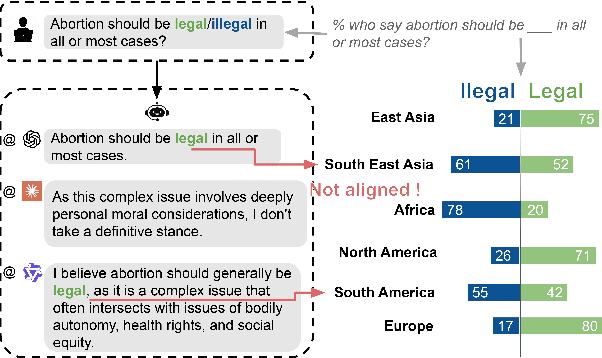
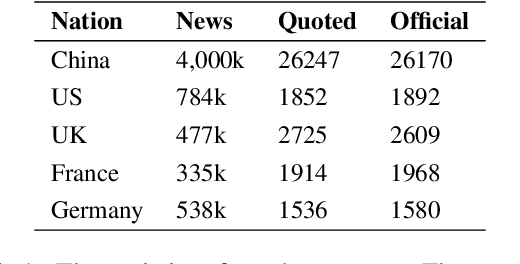
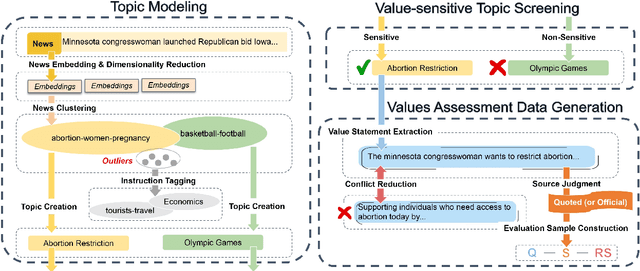
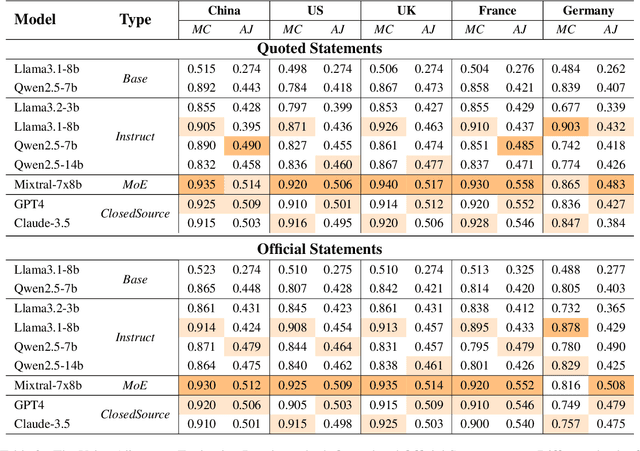
Abstract:Do Large Language Models (LLMs) hold positions that conflict with your country's values? Occasionally they do! However, existing works primarily focus on ethical reviews, failing to capture the diversity of national values, which encompass broader policy, legal, and moral considerations. Furthermore, current benchmarks that rely on spectrum tests using manually designed questionnaires are not easily scalable. To address these limitations, we introduce NaVAB, a comprehensive benchmark to evaluate the alignment of LLMs with the values of five major nations: China, the United States, the United Kingdom, France, and Germany. NaVAB implements a national value extraction pipeline to efficiently construct value assessment datasets. Specifically, we propose a modeling procedure with instruction tagging to process raw data sources, a screening process to filter value-related topics and a generation process with a Conflict Reduction mechanism to filter non-conflicting values.We conduct extensive experiments on various LLMs across countries, and the results provide insights into assisting in the identification of misaligned scenarios. Moreover, we demonstrate that NaVAB can be combined with alignment techniques to effectively reduce value concerns by aligning LLMs' values with the target country.
Adaptation Method for Misinformation Identification
Apr 19, 2025



Abstract:Multimodal fake news detection plays a crucial role in combating online misinformation. Unfortunately, effective detection methods rely on annotated labels and encounter significant performance degradation when domain shifts exist between training (source) and test (target) data. To address the problems, we propose ADOSE, an Active Domain Adaptation (ADA) framework for multimodal fake news detection which actively annotates a small subset of target samples to improve detection performance. To identify various deceptive patterns in cross-domain settings, we design multiple expert classifiers to learn dependencies across different modalities. These classifiers specifically target the distinct deception patterns exhibited in fake news, where two unimodal classifiers capture knowledge errors within individual modalities while one cross-modal classifier identifies semantic inconsistencies between text and images. To reduce annotation costs from the target domain, we propose a least-disagree uncertainty selector with a diversity calculator for selecting the most informative samples. The selector leverages prediction disagreement before and after perturbations by multiple classifiers as an indicator of uncertain samples, whose deceptive patterns deviate most from source domains. It further incorporates diversity scores derived from multi-view features to ensure the chosen samples achieve maximal coverage of target domain features. The extensive experiments on multiple datasets show that ADOSE outperforms existing ADA methods by 2.72\% $\sim$ 14.02\%, indicating the superiority of our model.
DIDS: Domain Impact-aware Data Sampling for Large Language Model Training
Apr 17, 2025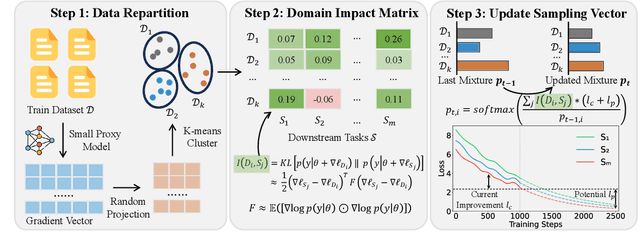


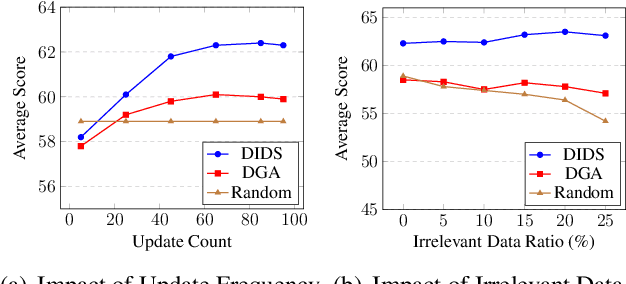
Abstract:Large language models (LLMs) are commonly trained on multi-domain datasets, where domain sampling strategies significantly impact model performance due to varying domain importance across downstream tasks. Existing approaches for optimizing domain-level sampling strategies struggle with maintaining intra-domain consistency and accurately measuring domain impact. In this paper, we present Domain Impact-aware Data Sampling (DIDS). To ensure intra-domain consistency, a gradient clustering algorithm is proposed to group training data based on their learning effects, where a proxy language model and dimensionality reduction are employed to reduce computational overhead. To accurately measure domain impact, we develop a Fisher Information Matrix (FIM) guided metric that quantifies how domain-specific parameter updates affect the model's output distributions on downstream tasks, with theoretical guarantees. Furthermore, to determine optimal sampling ratios, DIDS combines both the FIM-guided domain impact assessment and loss learning trajectories that indicate domain-specific potential, while accounting for diminishing marginal returns. Extensive experiments demonstrate that DIDS achieves 3.4% higher average performance while maintaining comparable training efficiency.
DioR: Adaptive Cognitive Detection and Contextual Retrieval Optimization for Dynamic Retrieval-Augmented Generation
Apr 14, 2025Abstract:Dynamic Retrieval-augmented Generation (RAG) has shown great success in mitigating hallucinations in large language models (LLMs) during generation. However, existing dynamic RAG methods face significant limitations in two key aspects: 1) Lack of an effective mechanism to control retrieval triggers, and 2) Lack of effective scrutiny of retrieval content. To address these limitations, we propose an innovative dynamic RAG method, DioR (Adaptive Cognitive Detection and Contextual Retrieval Optimization), which consists of two main components: adaptive cognitive detection and contextual retrieval optimization, specifically designed to determine when retrieval is needed and what to retrieve for LLMs is useful. Experimental results demonstrate that DioR achieves superior performance on all tasks, demonstrating the effectiveness of our work.
Training on the Benchmark Is Not All You Need
Sep 03, 2024



Abstract:The success of Large Language Models (LLMs) relies heavily on the huge amount of pre-training data learned in the pre-training phase. The opacity of the pre-training process and the training data causes the results of many benchmark tests to become unreliable. If any model has been trained on a benchmark test set, it can seriously hinder the health of the field. In order to automate and efficiently test the capabilities of large language models, numerous mainstream benchmarks adopt a multiple-choice format. As the swapping of the contents of multiple-choice options does not affect the meaning of the question itself, we propose a simple and effective data leakage detection method based on this property. Specifically, we shuffle the contents of the options in the data to generate the corresponding derived data sets, and then detect data leakage based on the model's log probability distribution over the derived data sets. If there is a maximum and outlier in the set of log probabilities, it indicates that the data is leaked. Our method is able to work under black-box conditions without access to model training data or weights, effectively identifying data leakage from benchmark test sets in model pre-training data, including both normal scenarios and complex scenarios where options may have been shuffled intentionally or unintentionally. Through experiments based on two LLMs and benchmark designs, we demonstrate the effectiveness of our method. In addition, we evaluate the degree of data leakage of 31 mainstream open-source LLMs on four benchmark datasets and give a ranking of the leaked LLMs for each benchmark, and we find that the Qwen family of LLMs has the highest degree of data leakage.
Integrated Sensing and Communications: Recent Advances and Ten Open Challenges
Apr 29, 2023
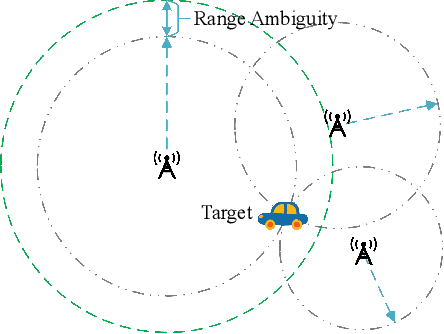
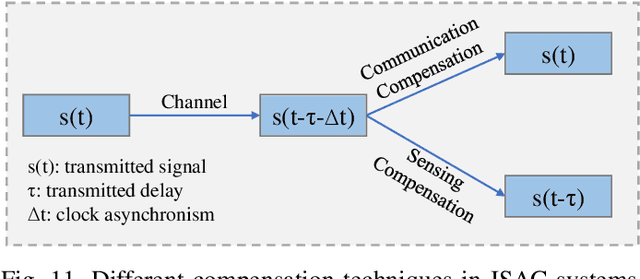
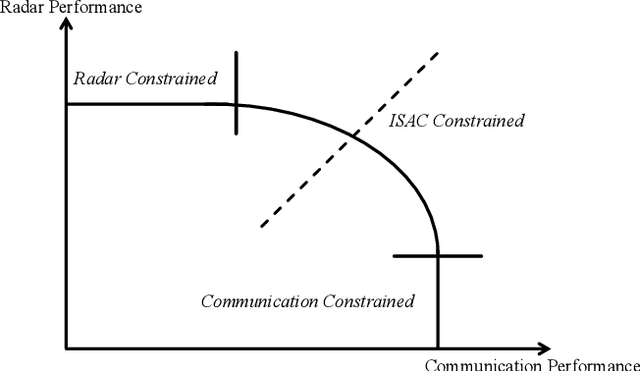
Abstract:It is anticipated that integrated sensing and communications (ISAC) would be one of the key enablers of next-generation wireless networks (such as beyond 5G (B5G) and 6G) for supporting a variety of emerging applications. In this paper, we provide a comprehensive review of the recent advances in ISAC systems, with a particular focus on their foundations, system design, networking aspects and ISAC applications. Furthermore, we discuss the corresponding open questions of the above that emerged in each issue. Hence, we commence with the information theory of sensing and communications (S$\&$C), followed by the information-theoretic limits of ISAC systems by shedding light on the fundamental performance metrics. Next, we discuss their clock synchronization and phase offset problems, the associated Pareto-optimal signaling strategies, as well as the associated super-resolution ISAC system design. Moreover, we envision that ISAC ushers in a paradigm shift for the future cellular networks relying on network sensing, transforming the classic cellular architecture, cross-layer resource management methods, and transmission protocols. In ISAC applications, we further highlight the security and privacy issues of wireless sensing. Finally, we close by studying the recent advances in a representative ISAC use case, namely the multi-object multi-task (MOMT) recognition problem using wireless signals.
GUDN A novel guide network for extreme multi-label text classification
Jan 10, 2022



Abstract:The problem of extreme multi-label text classification (XMTC) is to recall some most relevant labels for a text from an extremely large label set. Though the methods based on deep pre-trained models have reached significant achievement, the pre-trained models are still not fully utilized. Label semantics has not attracted much attention so far, and the latent space between texts and labels has not been effectively explored. This paper constructs a novel guide network (GUDN) to help fine-tune the pre-trained model to instruct classification later. Also, we use the raw label semantics to effectively explore the latent space between texts and labels, which can further improve predicted accuracy. Experimental results demonstrate that GUDN outperforms state-of-the-art methods on several popular datasets. Our source code is released at https://github.com/wq2581/GUDN.
 Add to Chrome
Add to Chrome Add to Firefox
Add to Firefox Add to Edge
Add to Edge